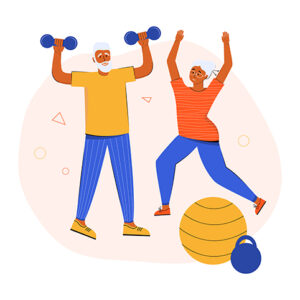
Study shows the importance of keeping active. Photo: Deposit Photos
Take it easy? A wonderful thought as you approach or are in the retirement phase of your life. That idea, however, is more of a factor in declining health than previously thought.
Inactivity is more to blame than age when older people lose the ability to do things on their own. Lack of physical activity also can lead to more visits to the doctor, more hospitalizations, and more use of medicines for a variety of illnesses, according to the National Institute on Aging.
Physical Activity and Sedentary Time Study
Previous research has shown that low physical activity and greater time spent sitting are associated with a higher risk of death. Does risk change if a person is genetically predisposed to live a long life?
That is the question researchers at the Herbert Wertheim School of Public Health and Human Longevity Science at University of California San Diego set out to answer in a study published in the August 24, 2022, online edition of the Journal of Aging and Physical Activity.
“The goal of this research was to understand whether associations between physical activity and sedentary time with death varied based on different levels of genetic predisposition for longevity,” said lead author Alexander Posis, M.P.H., a fourth-year doctoral student in the San Diego State University/UC San Diego Joint Doctoral Program in Public Health.
In 2012, as part of the Women’s Health Initiative Objective Physical Activity and Cardiovascular Health study (OPACH), researchers began measuring the physical activity of 5,446 women in the United States who were 63 and older, following them through 2020 to determine mortality. Participants wore a research-grade accelerometer for up to seven days to measure how much time they spent moving, the intensity of physical activity, and sedentary time.
The prospective study found that higher levels of light physical activity and moderate-to-vigorous physical activity were associated with a lower risk of death. Higher sedentary time was associated with a higher risk of mortality. These associations were consistent among women with different levels of the genetic predisposition for longevity.
“Our study showed that, even if you aren’t likely to live long based on your genes, you can still extend your lifespan by engaging in positive lifestyle behaviors such as regular exercise and sitting less,” said senior author Aladdin H. Shadyab, Ph.D., assistant professor at the Herbert Wertheim School of Public Health and Human Longevity Science at UC San Diego. “Conversely, even if your genes predispose you to a long life, remaining physically active is still important to achieve longevity.”
Given the aging adult population in the United States, and longer time spent engaging in lower intensity activities, the study findings support recommendations that older women should participate in physical activity of any intensity to reduce the risk of disease and premature death, wrote the authors.
More Reasons to Stay Physically Active
The National Institute on Aging notes that staying active can help you:
- Keep and improve your strength so you can stay independent
- Have more energy to do the things you want to do and reduce fatigue
- Improve your balance and lower risk of falls and injuries from falls
- Manage and prevent some diseases like arthritis, heart disease, stroke, type 2 diabetes, osteoporosis, and 8 types of cancer, including breast and colon cancer
- Sleep better at home
- Reduce levels of stress and anxiety
- Reach or maintain a healthy weight and reduce risk of excessive weight gain
- Control your blood pressure
- Possibly improve or maintain some aspects of cognitive function, such as your ability to shift quickly between tasks or plan an activity
- Perk up your mood and reduce feelings of depression
What Exercises To Do?
Find ones that will build your endurance, strength, and balance to prevent falls, and that will improve your flexibility.
Keep in mind that it is never too late to start!









